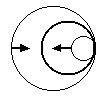 Local Preconditioning
Local Preconditioning
For more information see
webpage for preconditioning in CFD
An Overview
 Local preconditioning is a technique to remove stiffness from a system
of equations. In the context of the CFD community, typically the
set of time-dependent, Reynolds-averaged, ``Navier-Stokes''
equations are solved in an iterative fashion to achieve a
steady-state solution. Although only the steady-state solution is
desired, the time-dependent equations are employed so that the
system retains the desirable property of hyperbolicity (with
respect to time) for all Mach numbers. Thus, the system
has real eigenvalues and is comprised of wave-like solutions.
Local preconditioning is a technique to remove stiffness from a system
of equations. In the context of the CFD community, typically the
set of time-dependent, Reynolds-averaged, ``Navier-Stokes''
equations are solved in an iterative fashion to achieve a
steady-state solution. Although only the steady-state solution is
desired, the time-dependent equations are employed so that the
system retains the desirable property of hyperbolicity (with
respect to time) for all Mach numbers. Thus, the system
has real eigenvalues and is comprised of wave-like solutions.
 However, convergence to steady-state
is impaired for low Mach number regions due to the spread in
the characteristic wave speeds, e.g., q,
q+a, and q-a, where
q is the total flow speed and a
is the speed of sound. The ratio of the largest to smallest
wave speed is termed the condition number,
K, and serves as a measure of "stiffness".
In the plot of condition number versus Mach number shown at the right,
the solid line represents the Euler equations while the dashed
line represents the Euler equations preconditioned with the
Van Leer-Lee-Roe preconditioner.
As shown by the solid line, stiffness occurs in both the subsonic
and transonic regimes; and, as Mach increases, the condition
number approaches the ideal condition number: unity.
The dashed line shows that is it is possible to completely
eliminate the subsonic stiffness region, greatly reduce
the transonic stiffness region, and, in general, substantially
reduce the condition number for the system of equations.
However, convergence to steady-state
is impaired for low Mach number regions due to the spread in
the characteristic wave speeds, e.g., q,
q+a, and q-a, where
q is the total flow speed and a
is the speed of sound. The ratio of the largest to smallest
wave speed is termed the condition number,
K, and serves as a measure of "stiffness".
In the plot of condition number versus Mach number shown at the right,
the solid line represents the Euler equations while the dashed
line represents the Euler equations preconditioned with the
Van Leer-Lee-Roe preconditioner.
As shown by the solid line, stiffness occurs in both the subsonic
and transonic regimes; and, as Mach increases, the condition
number approaches the ideal condition number: unity.
The dashed line shows that is it is possible to completely
eliminate the subsonic stiffness region, greatly reduce
the transonic stiffness region, and, in general, substantially
reduce the condition number for the system of equations.
Benefits
- It removes the stiffness of the system of equations caused
by the spread in wave speeds, thus improving the
convergence rate of any marching scheme.
- It causes a system of equations to behave more like a
scalar equation, facilitating the design of concomitant
techniques.
In addition, some preconditioners decouple the system of
equations into purely elliptic and hyperbolic parts.
- It improves accuracy for low Mach number flows.
Detriments
- Without special considerations, time accuracy is lost.
Caveats
- Lack of robustness, especially in the vicinity of stagnation
points.
- Proper incorporation of Viscous effects is still unclear.
[Up]
 Local Preconditioning
Local Preconditioning
 Local Preconditioning
Local Preconditioning
 However, convergence to steady-state
is impaired for low Mach number regions due to the spread in
the characteristic wave speeds, e.g., q,
q+a, and q-a, where
q is the total flow speed and a
is the speed of sound. The ratio of the largest to smallest
wave speed is termed the condition number,
K, and serves as a measure of "stiffness".
In the plot of condition number versus Mach number shown at the right,
the solid line represents the Euler equations while the dashed
line represents the Euler equations preconditioned with the
Van Leer-Lee-Roe preconditioner.
As shown by the solid line, stiffness occurs in both the subsonic
and transonic regimes; and, as Mach increases, the condition
number approaches the ideal condition number: unity.
The dashed line shows that is it is possible to completely
eliminate the subsonic stiffness region, greatly reduce
the transonic stiffness region, and, in general, substantially
reduce the condition number for the system of equations.
However, convergence to steady-state
is impaired for low Mach number regions due to the spread in
the characteristic wave speeds, e.g., q,
q+a, and q-a, where
q is the total flow speed and a
is the speed of sound. The ratio of the largest to smallest
wave speed is termed the condition number,
K, and serves as a measure of "stiffness".
In the plot of condition number versus Mach number shown at the right,
the solid line represents the Euler equations while the dashed
line represents the Euler equations preconditioned with the
Van Leer-Lee-Roe preconditioner.
As shown by the solid line, stiffness occurs in both the subsonic
and transonic regimes; and, as Mach increases, the condition
number approaches the ideal condition number: unity.
The dashed line shows that is it is possible to completely
eliminate the subsonic stiffness region, greatly reduce
the transonic stiffness region, and, in general, substantially
reduce the condition number for the system of equations.